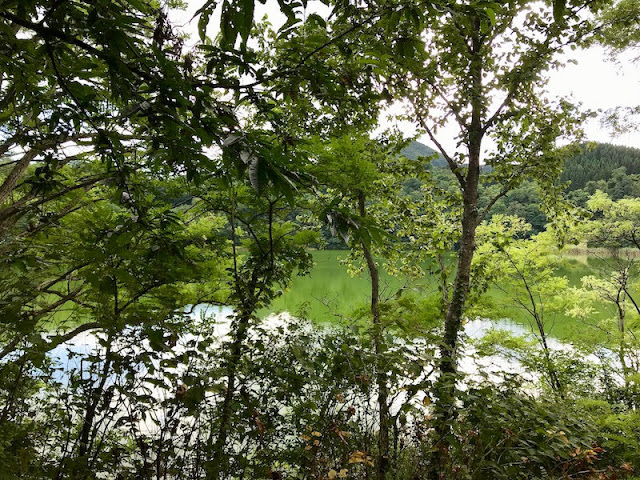花岡鉱山 Hanaoka Mine
Tsutsumizawa in Hanaoka mine (Odate city, Akita prefecture, Japan) was an open-cut site and became like a lake after mined.
北鹿の旅のつづき。花岡鉱山およびその南隣にある釈迦内、松峰の両鉱山の周辺を訪ねた。これら鉱山は大館盆地の北部に位置する。JR大館駅から北に車で10分、秋田自動車道の大館北インターからだと5分ほどで、交通の便はたいへんよい。以前は小坂鉄道の花岡線も通じた。この地の鉱床は、黒鉱型の塊状鉱床である。銅・鉛・亜鉛等の金属鉱床が平地にあるのは日本では珍しいだろう。
Hanaoka, Matsumine and Shakanai are kuroko-type metal mines located at the northern part of Odate basin. They are within a ten-minute driving distance from JR Odate station and Odate-Kita interchange of Akita Highway. It would be rare in Japan to find such metal mines at a flat open field.
花岡の鉱床は江戸時代から知られていたが、大々的に発展したのは1915年に藤田組(のちの同和鉱業)が小坂鉱山の支山として鉱業権を得てから。翌年には堂屋敷の大鉱床を発見、その後も次々と中小規模の鉱床を開発した。戦後、堤沢鉱床は露天掘りされた(冒頭の写真)。花岡の鉱床が枯渇しつつある1960年頃、花輪鉱山を経営していた日本鉱業が釈迦内地区で探鉱を開始し、すぐに大規模な黒鉱鉱床を発見した。同和鉱業も松峰地区で同様の鉱床を見出した。いわゆる黒鉱ブームである。これらの鉱床は埋蔵量3000万トンともいわれ、北鹿の鉱業界は大いに盛り上がったが、海外の安い鉱石には勝てず、釈迦内は1987年、松峰は1994年にそれぞれ閉山した。
The kuroko deposits in Hanaoka have been known in Edo period and largely developed since 1915 when Fujita-gumi began mining for supplement to Kosaka mine. Fujita-gumi soon found a large deposit in Doyashiki and other small-scale deposits. Tsutsumizawa was developed by open-cut mining after the Pacific War. In 1960 when the Hanaoka deposits were about to be exhausted, Nippon Mining succeeded in finding an underground kuroko deposit in Shakanai area on the south of Hanaoka, and Dowa Mining (former Fujita-gumi) followed in Matsumine. The possible reserves were said to be 30 million tons, but the mining business terminated by 1994.
大館郷土博物館 Odate City Museum
大館北インターから東に 2 km ほどの獅子ヶ森にある。大館地域の自然、歴史、風俗に関する展示がある。鉱山関係の資料もよくまとまっており、鉱山会社から寄贈された鉱石標本や採掘機械が並んでいる。
Odate local museum is located in Shishigamori that is about 2 km to the east of Odate-Kita interchange of Akita Highway, addressing the mining industry in Hanaoka area in addition to nature, history, and culture in Odate.
Explanation for mining method.
Specially manufactured for the use in Matsumine, Hopper Loader was able to collect and carry ores in the underground deposit and expanded the truckless mining.
Small pieces of minerals collected in Odate area.
An interesting specimen of kuroko that has a ring structure.
公害が社会問題になりつつあった1960年代に開発された釈迦内や松峰では、周囲が宅地や農地だったため、環境保全に対する意識は当初から高かったと思われる。たとえば1969年には鉱滓(浮遊選鉱後の泥、スライム)を日本海に面する能代の浅内浜まで輸送して処理するため、長大なパイプラインを建設した。また採掘された黒鉱鉱石は小坂等に送られ、当地では製錬はおこなっていない。鉱石の採掘は人工天盤下向き充填法によった。これはどういう方法かというと、まず深さ 3 m 分の黒鉱を掘り出したら、その空洞の底部厚さ 60 cm 分を鉄筋モルタルで固め、その上をモルタルで充填する。固まったら、その下の 3 m の黒鉱を掘り、以後繰り返す、というもの。これにより、軟弱な地盤でも安全に採掘をおこなうことができた。しかしそれでも地盤沈下が起こり、とくに鉱床の真上にあった松峰集落数十戸は集落ごと移転を余儀なくされた。他の地域でも家が傾くなどの問題が起こったようである。こうした問題に対する付随的なコストは鉱山の寿命短縮を招いたと想像される。
Shakanai and Matsumine were developed in the 1960s when people became aware of importance of environmental conservation. In 1969, a long pipeline was built to convey tailings from Odate to Asanai-Hama, Noshiro city, that faces the Sea of Japan. The mining method was as follows: After a kuroko layer of 3 m depth is mined, a floor of 60 cm height is created with mortar and reinforcing steel and the remaining space is filled with mortar. Then, the next 3 m layer beneath the solidified ceiling is mined further. Even with this mining method, Matsumine village located just above the kuroko deposit had to be moved because of ground subsidence.
Matsumine bus stop. Matsumine’s shaft and mining facilities were around the pyramidal hill. Matsumine village was forced to move from the right-hand side to the left-hand side of this road.
大館郷土博物館は鉱石標本や鉱山関連の展示の他にも、大館名産の曲げわっぱとか考古資料とか、興味深い展示が多数あった。あとこの博物館は美術館も兼ねていて、とくに東京・銀座で画廊を営む田中孝一氏が博物館に寄託した洋画のコレクションがたいへんすばらしかった。まさか博物館で絵画鑑賞ができるとは思わなかった。
Odate city local museum is also a museum of fine art. The collection is mainly offered by Koichi Tanaka who manages an art gallery in Tokyo. It was a surprise to me to see a lot of modern Japanese pictures.
近くにある釈迦内公民館の隣の「あやめ苑」という建物にも鉱山の資料が陳列されているというので見学した。博物館にいらっしゃった方がこんな施設もあるよ、というのでわざわざ連れて行ってくれて、鍵も開けてくれた。釈迦内鉱山の鉱石標本、鉱床の説明、鉱山の年表などがあった。あやめ苑は、もともとこのあたりの林業関係で財をなした旧家を移築して改装したもので、現在は公民館の別館として地元の方のサークル活動の場につかわれているようだ。秋田杉など立派な木材をふんだんにつかった、いまではそうそう造れないような建物だった。
I also visited Ayame House next to Shakanai community center. I met a person in Odate museum and she kindly told me about a display of ores and mining industry in Shakanai at Ayame House, which was a gorgeous traditional house built with plenty of local woods.
A map showing kuroko (red) and gypsum (yellow) deposits around Shakanai and Matsumine area.
鳥潟会館 Former Torikata Family Estate
江戸時代から花岡村の肝煎りを務めていた鳥潟家の住宅と庭園が市の施設として公開されている。呼び鈴を鳴らすと案内人の方が出て、いまちょうど別の見学者を案内中だからいっしょにどうぞ、と言われ、いっしょに見学した。たっぷり 40 分くらい見せてもらった。立派な大黒柱、京都から取り寄せたという庭石や床柱、古いボイラーとそれで沸かした湯が出る浴場、食料を冷やして保存するための深い穴蔵など、どれも興味深いものばかりだった。和室は使用料を払えば貸し切り利用できるそうだ。
土蔵が資料室になっていて、言えば見学させてもらえる。花岡の古い鉱石が置かれていたが、土蔵の環境が芳しくないのか、一部崩壊しつつあった。おもしろいのは松峰鉱山の立坑の模型。坑内で鉱石を「立坑ビン」に投入して、それを中間処理して巻き上げるまでのしくみを示している。
I visited the house of Torikata family, who served as a mayor of Hanaoka village for a long time in the Edo period. A guide explained big central pillars, tea rooms and garden, old boiler and bathroom, and a deep hole cellar to preserve foods. The storehouse is used as museum. There were ores from Hanaoka mine but some of them were decaying probably because of humid environment. An interesting thing was a model of Matsumine’s vertical shaft illustrating how the ores were gathered from adits and lifted to the ground level.
資料室には鳥潟小三吉(こさんきち、1842-1909)のコーナーもある。小三吉は軽業師で、明治初頭ヨーロッパを巡業して名声を得た。ドイツ人の妻とともに花岡に帰ったときは、まるで凱旋将軍のようだったという(森田一朗「サーカス」筑摩書房、1998)。鳥潟家はなかなか個性的な人材を輩出している。
There was a display about Kosankichi Torikata (1842-1909) who was an acrobat succeeding in Europe. When he returned to Hanaoka with his German wife, he was like a general after a victory.
花岡平和記念館 Hanaoka Peace Museum
太平洋戦争末期に起こった、いわゆる花岡事件を知るための施設である。鳥潟会館のすぐそばの花岡川のほとりにたつ。
事件の経緯については、たとえば「花岡の地・日中不再戦友好碑をまもる会」のホームページにある「花岡ものがたり」の縮小版や、紙芝居「二度とおこすな花岡事件」がわかりやすいとおもうので、そちらを参照のこと。ごく簡単に述べると、鹿島組(のちの鹿島建設)が請け負った鉱山関連の土木工事を中国人労務者900名超に従事させたが、食料や衣服が満足に与えられないなど、劣悪な労働環境の中、終戦までに400名以上が死亡した。労務者の蜂起とその鎮圧の顛末が強調されるが、本質的には強制労働の中で起こった「虐殺」事件といえる。
そもそも明治期の北海道開拓では俗に言う「タコ部屋労働」がおこなわれ、安い労働力を使い捨てする、目的は手段を正当化する、という風潮が昔から根付いていた。その延長線上で、日中戦争下の中国人捕虜や拉致に等しく連行した農民を極限まで(まさに「濡れたタオルの水が一滴もなくなるまで」)酷使したことは特段不思議なことではない。同胞の日本人すら「生きて虜囚の辱」を受けるなといわれて殺された時代であり、まして中国人の処遇はいうまでもなかった。中国人労務者に対する非人道的な扱いだけでなく、戦後、国や企業が事件を隠蔽しようとした形跡があることまでを含めて「事件」であり、そういう意味では事件はまだ終わっていないかもしれない。
ほっとしたこともあった。戦争中の食料や物資の不足する中、監督がいないすきに、腹をすかせた中国人に地元民が草だんごを食べさせた、という話が伝わっていること。また毎年6月30日には、中国から関係者を招いて慰霊式をおこなっていて、現在では暗い過去を反省する機会であるだけでなく、むしろ日中の交流の場として機能しつつあるということ。個人の辛い記憶は決してなくならないだろうが、いくばくかのなぐさめになる。
ここ花岡では、NPO法人の手によってではあるが、このような記念館がたち、歴史を風化させずに学び続けようという意志が息づいていることは、幸いなことである。いっぽうで、戦後七十余年がすぎても、いまだに韓国や北朝鮮、中国とのわだかまりがくすぶっている。せめて日本政府も戦争の歴史をあきらかにして学びの場を提供するような立派な施設を東京の真ん中に建てて、われわれ日本人や訪れる外国人に情報発信していけば、いつかそれを過去の事件としてふりかえる日が来るとおもう。
This is a memorial museum of Hanaoka massacre located by Hanaoka river near the Torikata family estate. During the Pacific War, Kajima contracted with Hanaoka mine (Fujita) for constructing works and hired 900 and more Chinese workers who came to Japan by compulsion. Because of forced labor and food scarcity, 400 and more people died until the end of the war. Though an uprising of the Chinese workers and its failure are often stressed, this is essentially a massacre in the course of forced labor.
In Japan, such forced labors had not been uncommon since Meiji period (e.g. the so-called Tako-Beya labor in Hokkaido). Human rights had considerably been violated until the new Constitution became effective in 1947. Even Japanese soldiers were killed by theirselves, not allowed to surrender, and so it is not surprising that Chinese people were abused just like wringing a wet cloth until no water drips.
I felt relieved to know some. Some local people in Hanaoka gave rice dumplings to the Chinese workers during the absence of the guards albeit in the circumstance of chronic food shortage. A ceremony is held every June 30th in Odate city with Chinese survivors and bereaved family invited, and this works as an opportunity not only for thinking over what we made but also for friendship between Japan and China.
補足
- 花岡の鉱床についてはこちらの記事にいくらか書いた。









